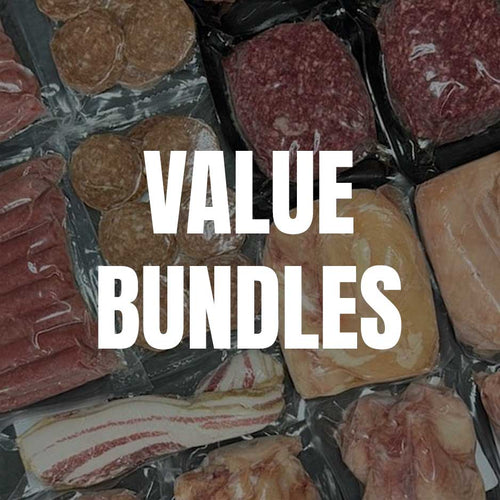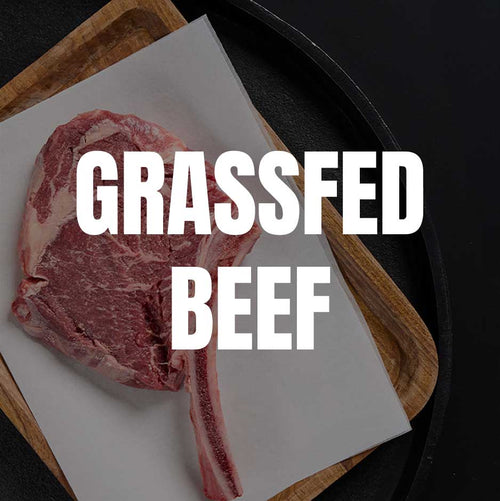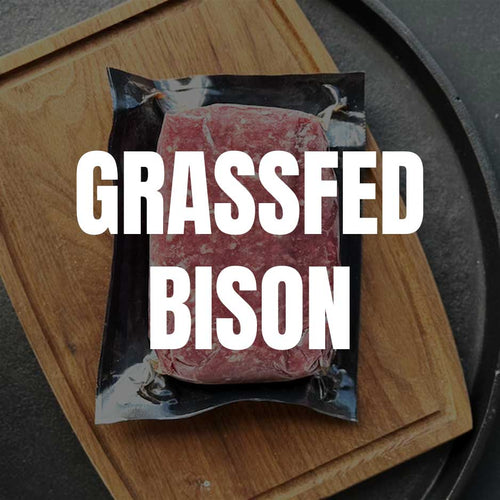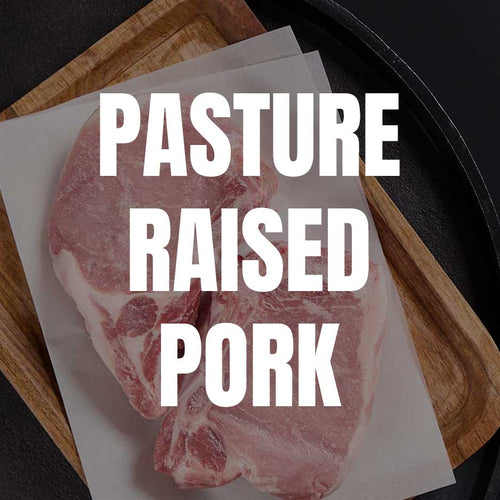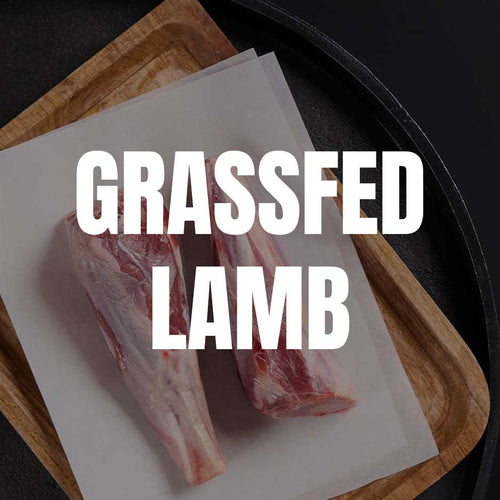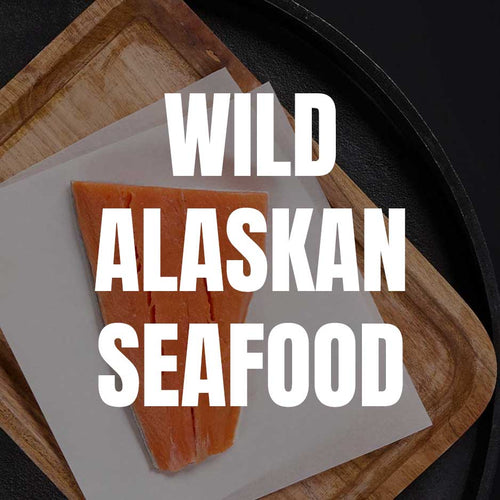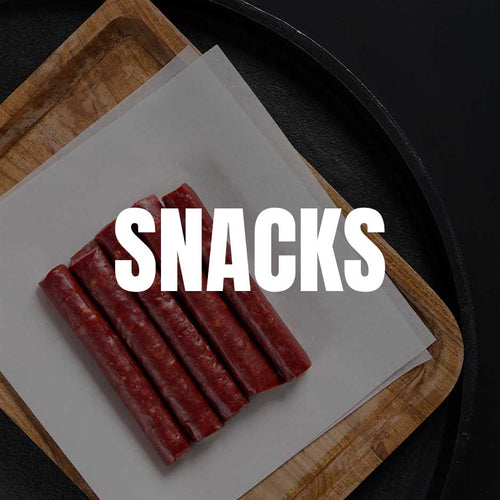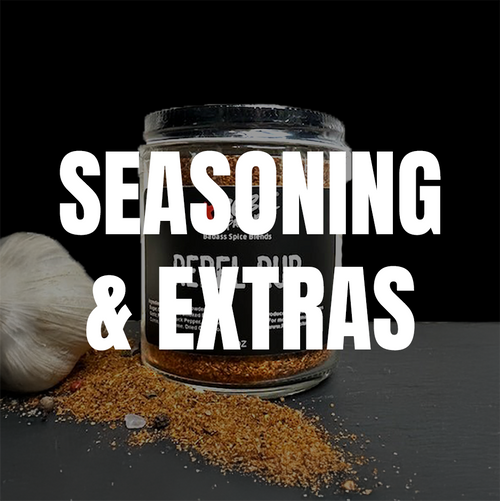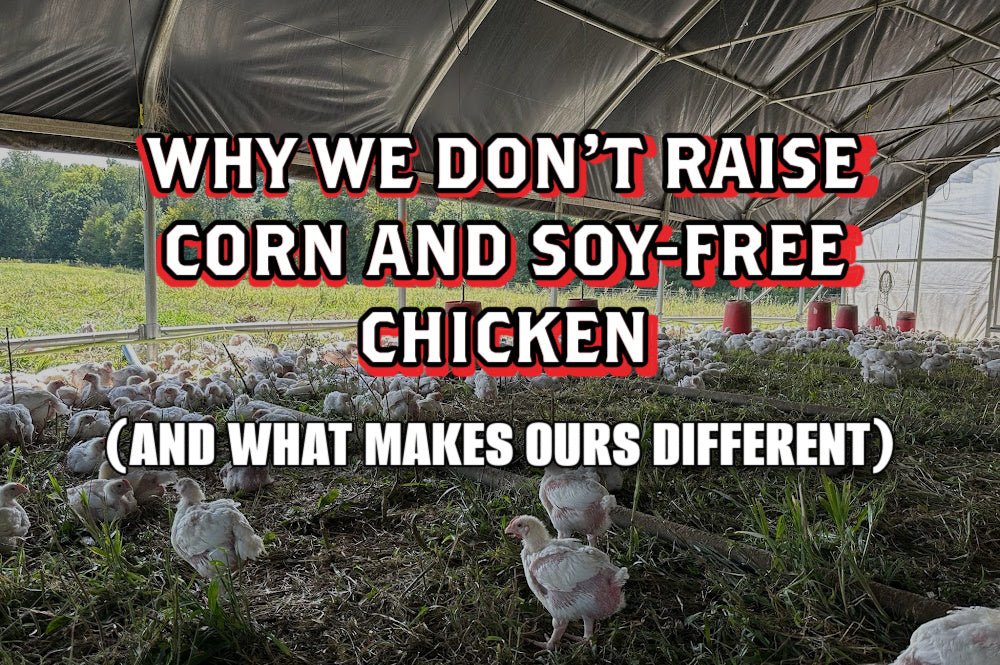
· By Jenni Bajema
Why We Don’t Raise Corn and Soy-Free Chicken (And What Makes Ours Different)
This has been a hot topic lately. A lot of it is coming from social media influencers talking about low PUFAs and “corn- and soy-free” chicken as the holy grail. And I get it, it makes for a great reel. But there’s a big difference between creating viral content online and building a farm business that’s sustainable, resilient, and able to feed real families week after week IRL.
The ironic part? I actually sat down to write this blog thinking maybe I’d convince myself that we should go corn- and soy-free. But after digging in deeper, I’ve never been more confident about the decision we’ve made.
Let me explain.
Why Most Farms Feed Corn and Soy to Chickens (and Why We Don’t Go Corn/Soy-Free)
Meat chickens need more protein than laying hens—and not just more, but a very specific nutritional profile to grow quickly and still stay healthy. Corn and soy, for better or worse, are complete, affordable, and widely available protein sources.
The trouble is, thanks to decades of government subsidies, crop insurance, and lobbying, farmers are overwhelmingly incentivized to grow only corn and soy. That means there aren’t enough alternative protein sources (like peas, flax, or sunflower) produced at scale. And when you can find them, they’re expensive and inconsistent.
Translation: it’s not just hard to find alternatives, it’s nearly impossible to feed them consistently without putting the flock—and ultimately our customers—at risk.
Corn and Soy-Free Chicken Comes With Higher Costs—Here’s Why
Because those alternatives are rare, they cost a lot more. Farms that do raise corn- and soy-free chicken are charging nearly double what we do. Most prices for corn- and soy-free chicken breasts are around $29/lb, compared to our $16/lb.
Now, we’re already a premium product. We raise on pasture, with regenerative methods, using non-GMO feed, and without antibiotics, vaccines, or chemicals. We refuse to cut corners. But if we were to go corn- and soy-free, we’d have to nearly double our prices—and that would push even more families out of reach of good, clean food.
And that’s not our mission.
Corn and Soy-Free Chicken vs Pasture-Raised: The Omega 6:3 Ratio Explained
A big driver behind the corn- and soy-free trend is the push to lower PUFAs (polyunsaturated fats). And yes, how animals are fed absolutely impacts the Omega 6:3 ratio in the meat. But here’s the breakdown:
- CAFO (confinement-raised) chicken: typically around ~15:1-30:1 Omega 6:3 or higher.
- Rebel Pastures chicken (pasture-raised, non-GMO grain, rotated daily): closer to ~7:1-9.1.
- Corn- and soy-free chicken: can sometimes test lower, depending on the exact feed formulation.
So yes, corn/soy-free may move the needle a bit further—but the biggest nutritional shift isn’t between our feed and theirs. It’s between pasture-raised chickens like ours and the industrial CAFO system. That’s where you see the most dramatic change in nutrient density and fatty acid profile. SO MUCH is dependent on the farm practices. You can read more about the hidden costs of industrialized meat in my blog: WHY THAT GROCERY STORE MEAT IS COSTING YOU MORE THAN YOU THINK
Our commitment is to raise birds that live outdoors, forage naturally, and balance their diet with non-GMO supplemental grains. That alone creates a nutrient profile worlds apart from conventional chicken.
Flavor, Growth, and Health Challenges With Corn- and Soy-Free Chicken
Corn and soy aren’t just cheap fillers - they also create consistent, balanced rations. When farms have experimented with alternatives like fishmeal or flax, they often run into problems with off-flavors in the meat, slower growth rates, and higher feed consumption.
That means you could end up with meat that doesn’t taste great or a bird that isn’t healthy. And while some customers might say they’re willing to pay more for corn- and soy-free, the truth is: not everyone loves the results once it hits the plate.
Beyond Corn and Soy-Free: What Really Matters in Pasture-Raised Chicken
So, when people ask us: “Do you feed corn- and soy-free?” I understand where it’s coming from. But I think the better question is:
“What farming practices reduce the need for chemicals, keep the animals healthy, and actually support regeneration?”
Because here’s what we can tell you with full confidence:
- Our chickens are raised outdoors on pasture, moving to fresh forage every single day.
- They’re supplemented with a non-GMO grain ration to meet their nutritional needs.
- We never use vaccines, antibiotics, or chemicals on our pastures.
- We raise with regenerative techniques that heal soil, build biodiversity, and restore balance.
That’s a huge difference from grocery store “pasture-raised” chicken, which is often raised indoors, barely touching grass, and still dependent on chemicals and industrial practices. I went deep into grocery store labels in this blog: THE TRUTH ABOUT CHICKEN LABELS: WHAT YOU NEED TO KNOW
Corn and Soy-Free Isn’t for Everyone—And That’s Okay
Let’s be real: not everyone will be able to eat our chicken. Some people do better with corn- and soy-free options. Some have unique health concerns that require strict protocols.
And that’s okay. We’re all biochemically unique. What works beautifully for one person might not work for another.
Our goal isn’t to be the only option—it’s to be an honest one. To raise food in a way that nourishes, regenerates, and remains accessible to as many people as possible.
Why Rebel Pastures Doesn’t Feed Corn- and Soy-Free (And What We Do Instead)
I understand this may mean some people won’t be able to eat our chicken. And I respect that.
But here’s what I want you to know: when you choose Rebel Pastures, you’re choosing a farm that balances nutrition, affordability, and regenerative impact. We’re not here to follow fads or chase viral content. We’re here to build a food system that lasts—one that supports families, farmers, and the land.
Like Joel Salatin says: “You have to do what’s right for you at the time.” And for Rebel, this is the right decision.
Because raising true pastured chicken that’s honest, regenerative, and accessible matters more than chasing labels or hype.
P.S. If you have questions about our feed or practices, reach out—we’ll answer them openly. I also wrote our most commonly asked questions here: YOUR QUESTIONS ABOUT CHICKEN - ANSWERED. And if corn/soy-free is a non-negotiable for your family, we respect that and are happy to point you toward farms that specialize in it.
References
- Effect of Different Dietary n-6 to n-3 Fatty Acid Ratios on the Performance and Fatty Acid Composition in Muscles of Broiler Chickens. Read Study
- Pasture and Feed Affect Broiler Carcass Nutrition. Read Study
Share:
1 comment
-
Hey
Loving your blog. Chicken! I don’t eat it and I don’t buy it bc it’s the size of a turkey breast.So again as I familiarizing myself with your brand and products I’m excited. We have stores filled with Frankenfoods.
Again thank y’all 💜
Theresa on


